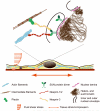Nuclear shape, mechanics, and mechanotransduction
- PMID: 18535268
- PMCID: PMC2717705
- DOI: 10.1161/CIRCRESAHA.108.173989
Nuclear shape, mechanics, and mechanotransduction
Abstract
In eukaryotic cells, the nucleus contains the genome and is the site of transcriptional regulation. The nucleus is the largest and stiffest organelle and is exposed to mechanical forces transmitted through the cytoskeleton from outside the cell and from force generation within the cell. Here, we discuss the effect of intra- and extracellular forces on nuclear shape and structure and how these force-induced changes could be implicated in nuclear mechanotransduction, ie, force-induced changes in cell signaling and gene transcription. We review mechanical studies of the nucleus and nuclear structural proteins, such as lamins. Dramatic changes in nuclear shape, organization, and stiffness are seen in cells where lamin proteins are mutated or absent, as in genetically engineered mice, RNA interference studies, or human disease. We examine the different mechanical pathways from the force-responsive cytoskeleton to the nucleus. We also highlight studies that link changes in nuclear shape with cell function during developmental, physiological, and pathological modifications. Together, these studies suggest that the nucleus itself may play an important role in the response of the cell to force.
Figures

References
-
- Discher DE, Janmey P, Wang YL. Tissue cells feel and respond to the stiffness of their substrate. Science. 2005;310:1139–1143. - PubMed
-
- Janmey PA, McCulloch CA. Cell mechanics: integrating cell responses to mechanical stimuli. Annu Rev Biomed Eng. 2007;9:1–34. - PubMed
-
- Vogel V, Sheetz M. Local force and geometry sensing regulate cell functions. Nat Rev Mol Cell Biol. 2006;7:265–275. - PubMed
-
- Lehoux S, Castier Y, Tedgui A. Molecular mechanisms of the vascular responses to haemodynamic forces. J Intern Med. 2006;259:381–392. - PubMed
Publication types
MeSH terms
Substances
Grants and funding
LinkOut - more resources
Full Text Sources
Other Literature Sources

